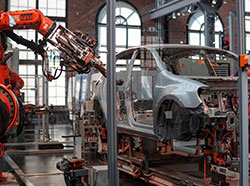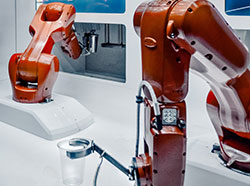On the Cutting Edge: Part 2
Top 4 Challenges
Solving the top 4 challenges of sensor-driven collaboration
The potential payoffs of sensor-driven collaboration are huge — from protecting workers during the pandemic to increased profitability and productivity and new revenue streams via innovative breakthroughs. But the automation continuum, which involves many different players and reams of data, comes with challenges. Fortunately, the four principal challenges can be solved using the same technologies that made the automation continuum possible in the first place.
1. Proximity to Humans
The context of vulnerable humans working amid powerful machines is inherently risky. The traditional approach has been to effectively bar humans from working around active robots. Shields, guardrails, and even completely separate rooms or buildings are employed. But in an era of cobots, this will no longer be feasible, as humans increasingly will inhabit close quarters with machines.
The good news is that edge technologies can be harnessed to protect humans. Ryan Braman, director of commercial products at TÜV Rheinland, a global robotics certification consultancy, says, “New types of sensing technologies, such as laser scanners, radars, and other types of electro-sensitive protective equipment, allow robots to sense where safety-related objects such as humans or stairs are and adjust their path or stop movement until the object is removed, enabling robots to work safely alongside humans. As the technology improves, the range of tasks that robots will be able to take on will also greatly improve.”9
Rigorous testing is required before a system can be considered safe. “Manufacturers will tell you they have a safe system right out of the box. But all they’re really giving you is the ability to create a safe cell. You have to consider the application and interact with it and test it rigorously,” says Braman.
Reality dictates that safety needs to be an integral part of design and development from the start. YuMi is a basic but highly programmable service robot from ABB Robotics. According to Nick O’Donnell, ABB global external affairs manager, “YuMi was designed to safely work in the immediate vicinity of human coworkers, even in the event of unintended contact. It has physical and software safety features including lightweight soft-padded arms; motion control software; speed-limited hardware; and no pinch points on each of its dual, seven-axis arms,” says O’Donnell.
2. Data Overload
A vastly higher level of machine awareness makes for an industrial environment rich in sensor-derived data but potentially stretched too thin in the processing and analytics departments. Traditional computing strategies and frameworks can be overwhelmed, sabotaging the benefits of a robot-intensive workforce.
The solution is at the edge. “Pushing all this data out somewhere else for processing — into the cloud — is no longer practical, nor does it make sense,” says Wind River Senior Director of Product Management Michel Chabroux. At the edge in robotics, “we increase productivity, because with artificial intelligence and access to so much data, the robot can make decisions much faster than humans — and statistically speaking, the robot will always make the best possible decision.”
A robot driven by data gathered and processed at the edge is able to detect the likelihood of its breakdown or, at the very least, the failure to maintain quality standards. Communicating with the other robots on the assembly line, the at-risk machine shuts down while others adapt their workflow in real time to make up for the missing worker. The production line slows but doesn’t stop. A human technician intervenes, making the needed adjustment or repair, and then the system returns to full speed. The only way this and related capabilities can be realized is through the edge.
3. Cybersecurity
As robots become mobile, collaborative, edge resident, and connected to internal and external sensors and IoT devices, the data-rich ecosystem opens itself to multiple access points for would-be hackers. Companies may find themselves vulnerable to malware, cyber ransom, production delays, and business disruption. What’s more, cyberattacks targeting highly nimble, powerful robotic systems also come with some serious physical safety concerns.
The solution? A comprehensive, unified, end-to-end approach to cybersecurity. It starts with device manufacturers: “When designing a product, developers need to make sure they are implementing security measures throughout the design process and writing firmware that is as secure as possible,” says Nigel Stanley, CTO at TÜV Rheinland.10 From there, systems integrators need to understand the machines they’re installing and the overall environment, with an eye toward identifying potential access points and hardening vulnerable targets. Finally, the operator’s IT team needs to be actively engaged, monitoring threats and updating security measures.
Security issues can arise even when a device no longer needs to be in service, points out Arlen Baker, principal security architect at Wind River. “It is vital to have a decommissioning process that ensures that sensitive software or data on the device is cryptographically sanitized, so there is nothing remaining on the device to reverse-engineer,” he says.
4. Price
The cost of robots is becoming less of an issue, as advanced technologies and new business models drive economies of scale. According to McKinsey, 16% of prospects for industrial robotics see cost as their number-one challenge — with 53% viewing the issue as one of their top five concerns.11 But with the rise of Robots-as-a-Service (RaaS), more manufacturers are becoming service providers, allowing customers to scale the number of running units depending on demand.
Computing, data communication, and storage advances continue to deliver more capabilities at a lower cost. “AI and machine learning algorithms have become more efficient, making it easier to program robots, devise new use cases, and reduce the energy required to run them,” notes Richardson at Wind River. “While some believe that Moore’s law is no longer true in terms of the quantity of transistors, it continues to be valid in terms of the cost of computing, as more and more capabilities become available at lower processing prices.”



Senior Director, Product Management
Wind River